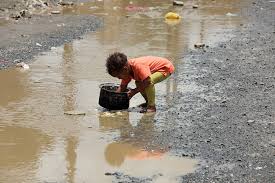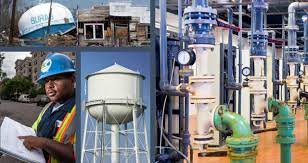A water emergency is any event that disrupts the normal supply of clean water to your home. Water issues and problems in developing countries are diverse and serious: Problems include the natural scarcity of drinking water in certain areas, floods, the siltation of river systems, as well as the contamination of rivers and large dams.
These problems are more severe and widespread in the developing countries than in developed countries. Some 1.1 billion people in developing countries have inadequate access to clean water. 2.6 billion lack access to sanitation. 1.8 million children die each year from diarrhea and millions of women spend hours a day collecting water.
Barriers to addressing water problems in developing nations are focused mainly around issues of poverty, education, and poor governance. Despite the many seemingly intractable problems, there are also many low-tech low-cost solutions in use around the world, which provide health, albeit on a small scale.
Humanity demands a need for freshwater for agricultural, industrial, and commercial processes like the production of beer, food, and refined oil. With a rising demand, the quality and supply of water diminishes drastically on top of an increasing waste and scarcity.
To address this challenge, organizations have begun to focus on increasing the supply of freshwater, mitigating its demand, and enabling reuse and recycling.
Approximately 71.230% of all illnesses in developing countries are caused by poor water and sanitation conditions. It is common for women and girls to have to walk several kilometers every day to fetch water for their families. Once filled, water jugs can weigh as much as 20 kg .
In the last century, water use has greatly outpaced the rate of population growth: people are using more water than ever before. By 2025, up to 1.8 billion people could face water scarcity. Water scarcity can take two forms: physical water scarcity, or low quantity of water, and economic water scarcity, or low quality of water.
Water emergencies can be caused by natural disasters or other emergencies that affect the water system: Hurricanes, Floods, Tornadoes, Forest/brush fires, Droughts, Earthquakes, Chemical spills, broken water main, Power outage, Failure of storage tanks or other equipment, Contamination of water.
Read Also: Meaning and Concepts of Design of Waste-water Treatment Units
Physical Water Scarcity

Earth‘s most dominant feature at first glance is the ocean, taking up approximately 70% of the planet‘s surface, connected to major lakes, watersheds, and waterways; whether it‘s through a channel or through the water cycle.
Explained by the United States Geological Survey (USGS), the scarce of fresh water resource and push for supplying water of it is already a growing vital issue, especially in many arid regions around the world.
These dry regions do not have the access to fresh water resource in common bodies of water such as lakes and rivers; most of the fresh water sources in these areas are groundwater that are limited and quickly reducing as it becomes contaminated into brackish water and people continue to extract from the well.
The scarcity of freshwater resource has been a growing issue for centuries and less than 2.5% of the water on Earth is freshwater, and of it, about 0.014% is available to humans as groundwater mitigates due to constant groundwater tapping and the rest sit in untouched ice caps and glaciers.
This term typically applies to dry, arid regions where fresh water naturally occurs in low quantities. This is being greatly exacerbated by anthropogenic activities that take surface and ground water faster than the environment can replenish it. Regions most affected by this type of water scarcity are Mexico, Northern and Southern Africa, the Middle East, India, and Northern China.
Economic water Scarcity
Economic water scarcity applies to areas or cultures that lack the fiscal resources and/or human capacity to invest in water sources and meet the local demand.
Water is often only available to those who can pay for it or those in political power; leaving millions of the world’s poorest without access. Regions most affected by this type of scarcity are portions of Central and South America, Central Africa, India, and South East Asia.
It is important to highlight the distinction between these two forms of scarcity: water can be physically available, but the resources are not available to improve it and distribute it to those who need it.
Case Study of Some Nations
1. India
India’s growing population is putting a strain on the country’s water resources. The country is classified as “water stressed” and a water availability of 1,000-1,700 m3/person/year. According to UNICEF, in 2008 88% of the population had access and was using improved drinking water sources.
“Improved drinking water source” is an ambiguous term, ranging in meaning from fully treated and 24-hour availability to merely being piped through a city and sporadically available. This is in part due to large inefficiencies in the water infrastructure in which up to 40% of water leaks out.
In the same 2008 UNICEF report, only 31% of the population had access and used improved sanitation facilities. Open sewers are common place in urban areas. A little more than half of the 16 million residents of New Delhi, the capital city, have access to this service.
Every day, 950 million gallons of sewage flows from New Delhi into the Yamuna River without any significant forms of treatment. This river bubbles with methane and was found to have a fecal coliform count 10,000 time than the safe limit for bathing.
Due to surface water contamination due to lack of sewage treatment and industrial discharge, groundwater is becoming increasingly dependent on and exploited in many regions of India. This process is being expedited by heavily subsidized energy costs for agriculture practices; which make up roughly 80% of India’s water resource demand.
2. Kenya
Kenya, a country of 36.6 million, struggles with a staggering population growth rate of 2.6% per year (by comparison, the US population growth rate is 0.9% and the population growth rate in India is 1.31%).This high population growth rate has pushed Kenya’s natural resources to the brink of destruction.
Much of the country suffers from a severe arid climate, with only scarce few areas enjoying rain and access to water resources. Deforestation and soil degradation have made the available surface water typically highly polluted and difficult to retain.
The government has been unable to afford to develop water treatment or distribution systems, leaving the vast majority of the country without access to water.
This has also exacerbated gender politics, as 74% of women must spend an average of 8 hours per day securing water for their families.
The growing population and stagnant economy has exacerbated urban, suburban, and rural poverty – exacerbated by lack of access to clean drinking water which leaves much of the non-elite population suffering from disease and parasites.
This has effectively crippled Kenya’s human capital. Private water companies have taken up the slack from Kenya’s government among the wealthy, but the Kenyan government prevents them from moving into the poverty-stricken areas of the country in order to stop profiteering off the poor.
Unfortunately, since Kenya’s government also refuses to provide services, this leaves the disenfranchised with no options at all for obtaining clean water or any water.
3. Bangladesh
Historically, water sources in Bangladesh came from surface water contaminated with bacteria. As a result of drinking infected water, infants and children suffered from acute gastrointestinal disease, causing significant burden of mortality.
During the 1970s, UNICEF worked with the Department of Public Health Engineering to install tube-wells, which drew water from underground aquifers, to provide a presumably safe source of water for the nation.
As of 2010, 67% of the Bangladeshis had a permanent water source and majority of them used tube wells. The wells consist of tubes 5 cm in diameter that were inserted less than 200 m into the ground, and capped with an iron or steel hand pump.
At that time, standard water testing procedures did not include arsenic testing. This lack of precaution led to one of the largest mass poisoning of a population twenty years later because the ground water used for drinking is naturally contaminated with arsenic.
Because arsenic has no taste, no smell, and no color, its long term health risks can be harder for the inhabitants to grasp compared to the immediate threats caused by diarrhea.
Nonetheless, intervention measures such as awareness programs and painting tube- wells red if the water is above the government limit of 50 ppb arsenic (green otherwise) have seen success. As of 2010, 80% of Bangladeshis recognize arsenic as a problem.
Available options for providing safe drinking water include deep wells, traditional dug wells, treatment of surface water, and rainwater harvesting. Between 2000 and 2009, more than 160,000 safe water devices have been installed in arsenic-affected regions of Bangladesh
In conclusion,for human consumption, various innovations and solutions (both high and low- technology based) exist throughout the developing world to treat water at the point of use (PoU) and have been shown to an effective solution to addressing poor quality water supplies.
Studies have shown that PoU treatment to reduce diaherrea mortality in children under 5 by 29% However, home water treatment solutions may not be widely considered in development strategies, as they are not recognized under the water supply indicator in the United Nations Millennium Development Goals.
Additionally, various challenges may reduce the effectiveness of home treatment solutions- such as low education, low-dedication to repair and replacement (especially if the treatment was initially free, did not meet expectations or was time intensive), or local repair services or parts are unavailable.
Despite the clear benefits of improving water sources (a WHO study showed a potential economic benefit of $3–34 USD for every $1 USD invested), aid for water improvements have declined from 1998 to 2008 and generally is less than is needed to meet the MDG targets.
In addition to increasing funding resources towards water quality, many development plans stress the importance of improving policy, market and governance structures to implement, monitor and enforce water quality improvements.
Read Also: Efficiency and Maintenance of Waste-water Treatment Units
Read Also: The Marvels of Mushrooms: From Culinary Delights to Medicinal Wonders

